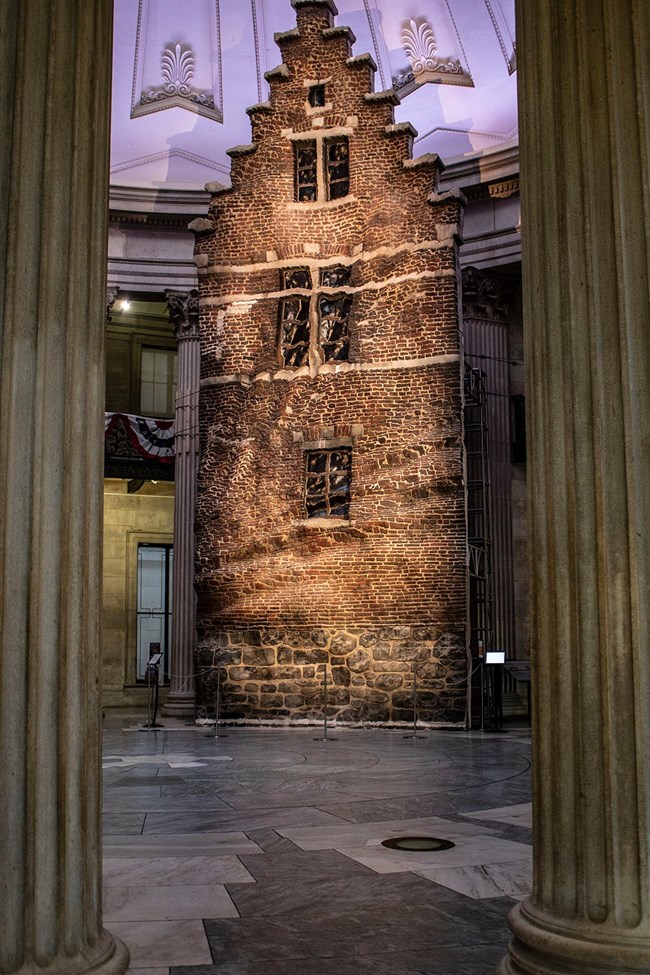Last updated: October 3, 2018
Article
Eureka: 40-Foot High Sculpture on Display at Federal Hall National Memorial

NPS PHOTO
But those slender, gabled canal houses with their Flanders-brick facades were hardly the only legacy of 40 years of Dutch rule, from 1624-1664. What made New York unique among the American settlements was that the Dutch also instilled the values of religious freedom and free trade, well over a century before the first Congress enshrined those freedoms at Federal Hall, in what became known as the Bill of Rights.
Eureka, located in the Federal Hall National Memorial rotunda, is a 40-foot-high facade of a 17th-century gabled Dutch canal house. The one-ton hand-painted sculpture is by Brian Tolle. Originally Commissioned by curator Jan Hoet for his exhibition titled “Over the Edges” in Ghent, Belgium, Tolle replaced the façade of a 17th-century Flemish canal house with a three-dimensional version of its reflection in the water below, blurring the border between architecture and its environment.
Tolle named the facade “Eureka” for the exclamation of discovery often attributed to Archimedes. The exhibition is a collaboration of the New York State Archives, the Archives Partnership Trust, the National Park Service and the National Parks of New York Harbor Conservancy. It will be on display through September 8, 2018.
More About the Artist
Brian Tolle's sculptures and installations emphasize a formal and iconographic dialog with history and context. Architecture, site and technology are recurring themes. Using a variety of media, his work draws from the scale and experience of its surroundings, provoking a re-reading by cross-wiring reality and fiction. Drawing ideas from a broad-based conceptual analysis Tolle blurs the border between the contemporary and the historical. His approach involves in depth research, which is then distilled and directed creating an intuitive personal response. His public works include Irish Hunger Memorial, Battery Park City, NYC, NY, a one-half acre sculpture on the Hudson River. Other notable public works include: Pageant, New York, NY, 2017, Outflow, Calgary, AB, Canada, 2015, Origin, University of Houston, Houston, TX, 2014, Simnai Dirdro (Twisted Chimney), Rhymney, Wales, UK, 2010, Remembering Walter H. Dubner, Los Angeles, CA, 2010, Tempest, 2010 recently installed at Crystal Bridges Museum of American Art, Bentonville, AR, 2018, and Stronghold, the University of Washington, Seattle, WA, 2007. He is currently the artist lead of the East Midtown Waterfront Project, a 1-mile esplanade between East 38th st and East 60th st along New York City’s East River. Brian Tolle's work has been exhibited in the Whitney Biennial, Liverpool Biennial at the Tate Modern, Kunsthalle Bern, Switzerland, the S.M.A.K. in Ghent, Belgium, Institute of Contemporary Art, Philadelphia; Contemporary Arts Center, Cincinnati; the Queens Museum of Art, New York, Havana Biennial, Cuba, the Invitational Exhibition at the American Academy of Arts and numerous other institutions. He is the recipient of awards from the Irish American Historical Society, the Louis Comfort Tiffany Foundation, and the Design Commission of the City of New York. His most recent solo show was exhibited at the University Art Museum at SUNY Albany.
